
- Khan Academy roped in OpenAI’s GPT-4 to create Khanmigo, an AI tutor who never had to endure school lunches.
- UC San Diego Health & UW Health deployed AI to draft patient responses; Doctors: “Our new favorite colleague doesn’t even need coffee breaks!”
- WPP spiced up ad campaigns with AI, because who wouldn’t want a virtual Shah Rukh Khan selling chocolates?
- VentureBeat is rolling out AI-assisted articles, giving reporters a new non-human entity to blame for typos.
- King (the maker of Candy Crush) utilizes AI for game testing, because apparently, humans alone couldn’t get enough of crushing candies.
- GrammarlyGO is our Tool of the Trade for the week.
- The Step-by-step reasoning is our Prompting technique of the week.
As you probably read in the Free Edition introduction, the readers of Synthetic Work that have a paid membership, like you, have now access to a new database: How to Prompt.
All the techniques that we describe in the Prompting section below, and others, will end up in the How to Prompt database so you don’t have to go hunt them across multiple Splendid Editions.
Let me know if you like the implementation and if the tool is useful to you.
Alessandro
What we talk about here is not about what it could be, but about what is happening today.
Every organization adopting AI that is mentioned in this section is recorded in the AI Adoption Tracker.
In the Education industry, the online education platform Khan Academy has partnered with OpenAI to create an AI tutor for students and an AI assistant for teachers.
We knew this since the OpenAI announcement of GPT-4, but now, in this new TED Talk, Khan Academy’s CEO shows how GPT-4 is now powering their new tool Khanmigo:
Two things to notice here:
- There is a huge amount of prompt massaging going on. Not just in controlling the kind of output that GPT-4 generates, but also in setting up a personality for the AI and a certain type of approach in offering the answers.The used prompting techniques are clearly different for the AI tutor version and for the AI teaching assistant version. Many of those techniques you find in the new How to Prompt section of Synthetic Work.
- When you watch this video, you realize how the addition of a synthetic voice would have a gigantic impact on our interactions with the AI. And how it seems inevitable that OpenAI’s next models will have to include synthetic voice generation.If you want a glimpse of how synthetic voices able to express emotions are a game changer, you just need to listen to my work-in-progress Fake Show.
–
In the Health Care industry, UC San Diego Health, in California, and UW Health in Wisconsin, are using OpenAI models to draft responses to patient questions.
Nidhi Subbaraman, reporting for the Wall Street Journal:
In California and Wisconsin, OpenAI’s “GPT” generative artificial intelligence is reading patient messages and drafting responses from their doctors. The operation is part of a pilot program in which three health systems test if the AI will cut the time that medical staff spend replying to patients’ online inquiries.
…
UC San Diego Health and UW Health began testing the tool in April. Stanford Health Care aims to join the rollout early next week. Altogether, about two dozen healthcare staff are piloting this tool.
…
Marlene Millen, a primary care physician at UC San Diego Health who is helping lead the AI test, has been testing GPT in her inbox for about a week. Early AI-generated responses needed heavy editing, she said, and her team has been working to improve the replies. They are also adding a kind of bedside manner: If a patient mentioned returning from a trip, the draft could include a line that asked if their travels went well. “It gives the human touch that we would,” Dr. Millen said.
…
Epic, the company based in Verona, Wis., that built the “MyChart” tool through which patients can message their healthcare providers, saw logins more than double from 106 million in the first quarter of 2020 to 260 million in the first quarter of 2023. Epic’s software enables hospitals to store patient records electronically.Earlier this month, Epic and Microsoft announced that health systems would have access to OpenAI’s GPT through Epic’s software and Microsoft’s Azure cloud service
…
The AI pilot has some healthcare staff buzzing, said Dr. Millen. “Doctors are so burnt out that they are looking for any kind of hope.” That hospital system saw patient messages jump from 50,000 messages a month before the pandemic, to over 80,000 a month after, with more than 140,000 messages in some pandemic months, Dr. Millen said.
…
The AI drafts reference the patient’s medical record when it proposes a response, for example, mentioning their existing medication or the last time they were seen by their physician.
…
For now, the San Diego team has stopped the AI from answering any query that seeks medical advice. Similarly in Wisconsin, the 10 doctors at UW Health have enabled AI responses to a limited set of patient questions, including prescription requests and asks for documentation or paperwork, according to Chero Goswami, chief information officer at UW Health.
Couple this information with the results of the study we saw in this week’s Free Edition of Synthetic Work: patients prefer the answers of the AI to the ones of grumpy human doctors.
Also, couple this information with the the other examples of how different types of AI are being implemented for various scenarios in the Health Care industry. We discussed many of them in Issue #4 – Medical AI to open new hospital in the metaverse to assist (human) ex doctors affected by severe depression.
–
In the Advertising industry, the giant communication company WPP used generative AI to create ads with Bollywood actors and sport superstar (and for a myriad of other tasks).
Mark Sweney, reporting for The Guardian:
Mark Read, the chief executive of London-listed WPP, the world’s largest marketing services company, said AI-led advertising practices were helping it win clients hungry to embrace the potential of a new technology.
“It is fundamental to WPP’s business in the future,” said Read, who added that he had tried the Microsoft-backed AI-powered search tool ChatGPT. “I would say that it has helped us win new business. We have been investing in it for a number of years.”
WPP paid an estimated £75m to buy Satalia, a London-based AI tech firm, two years ago as it sought to infuse the burgeoning technology into its creative and media-buying practices.
…
Recent applications include creating an ad campaign for Nike’s 50th anniversary, called Never Stop Evolving, featuring Williams facing off against versions of herself throughout her career.In India, machine-learning was used to create a campaign for the Mondelēz-owned Cadbury featuring Shah Rukh Khan, which enabled the development of “millions” of personalised ads using the Bollywood star’s voice to help promote local businesses that struggled during the Covid pandemic.
Cadbury is the second largest confectionery brand in the world after Mars and this particular ad campaign is called “Not Just A Cadbury Ad Campaign”.
I highly recommend you to watch this short video that gives a glimpse of how WPP and Ogilvy Mumbai used generative AI to produce thousands of variants of the same ad, each showing a unique reference to a specific Indian store and the synthetic voice of Shah Rukh Khan mentioning that store.
This is genius.
–
In the Publishing industry, the notorious online publication VentureBeat has announced its roll-out of generative AI to produce articles.
From the editorial director himself, Michael Nuñez, in a memo to the staff:
My vision is for our reporters and editors to use generative AI as a creative partner, not as a replacement for human judgment. To be explicitly clear, we do not blindly copy and paste what tools like ChatGPT generate, nor do we let AI write entire stories. Instead, we will use AI to inspire and strengthen our work — overcoming writer’s block, improving our storytelling, and exploring new angles. Our human copyeditors will always review, edit and fact-check VentureBeat stories, whether they contain AI-influenced content or are written without any generative AI assistance.
…
The game has changed — it is no longer a choice whether to use AI in the newsroom but a necessity if we want to better serve our readers. The technology has matured to the point where it can be a creative partner rather than just a utility.We can either compete against AI or collaborate with it. At VentureBeat, we choose to collaborate — and shape the future of media in the process.
The last editor that swore that AI-generated articles would be fact-checked by the staff was Connie Guglielmo at CNET. The day after that, people uncovered horrific mistakes in the articles of CNET Money, as we discovered in the epic Issue #5 – The Perpetual Garbage Generator fully dedicated to the Publishing industry.
How to read VentureBeat memo:
“Our competitors are publishing more stories than us much faster than us because of generative AI. Our best human writers are going elsewhere, where they are paid more money. The only way out we see is by joining the Perpetual Garbage Generation party.
We are not the first doing this, so the public will not blame or shame us. We’re good.
Oh. Perhaps the intern coming from the local high school will check the articles the AI has generated. But only after they have been published. And only if somebody complains.”
–
In the Gaming Industry, King, the game studio that developed Candy Crush, is using AI for level design and testing.
Chris Tapsell, reporting for Eurogamer:
The most obvious sign of AI’s “arrival” this year was one specific talk: The Future of AI in Gaming, a panel sponsored by Candy Crush developer King, featuring the company’s chief technology officer Steve Collins and Candy Crush’s head of creative Paul Stephanouk, plus speakers from Sony, Unity, and Level Up Games.
Long before the talk was due to start it was packed out to fire code capacity, with attendees lining the walls of the room – I got there myself a good 20 minutes beforehand and it was already full. More bizarrely, scores of attendees who couldn’t get in and knew the talk was completely full actually stayed in line, for the duration of the talk, in the hope that dozens of people ahead of them might leave early and vacate a spot.
…
Speaking to Eurogamer after the talk, Collins explained the studio’s stance in more detail. Its ambition is to pivot to being an “AI-first company,” he said, in the wake of its acquisition of Swedish AI company Peltarion in mid-2022.The way King uses AI now is primarily for testing – a theme which came up a few times across speakers and interviews but in King’s case is specifically a question of scale. Candy Crush, he explained, effectively alters its levels to be bespoke in difficulty for each individual player, and at the scale he mentioned – “230 million monthly players” and now over 13,000 levels – AI is really the only option. “It’s really hard to do that if you don’t have a million players playing the level all the time in your back pocket.” What the AI does in this case is essentially “play those levels as if they were a human player”.
…
Designers at King “use AI in order to initially design a level, tweak the level, and get it to where we want it to be, and then our testers come in, and they use AI to really shake the level out and see if it does exactly what we want it to do”.
The long article is full of other examples of gaming studios that are considering the use of AI for a myriad of scenarios, but most are hypothetical or at the prototype stage. As the readers of this newsletter know, I try not to mention use cases that have not reached at least a pilot stage. That said, the piece is well worth a read.
Every company mentioned in this section is also in the new AI Adoption Tracker.
Before you start reading this section, it's mandatory that you roll your eyes at the word "engineering" in "prompt engineering".
Today we try to force GPT-4 to give us more articulated and higher-quality answers by asking it to reason step by step.
As usual, let’s start with a basic prompt:
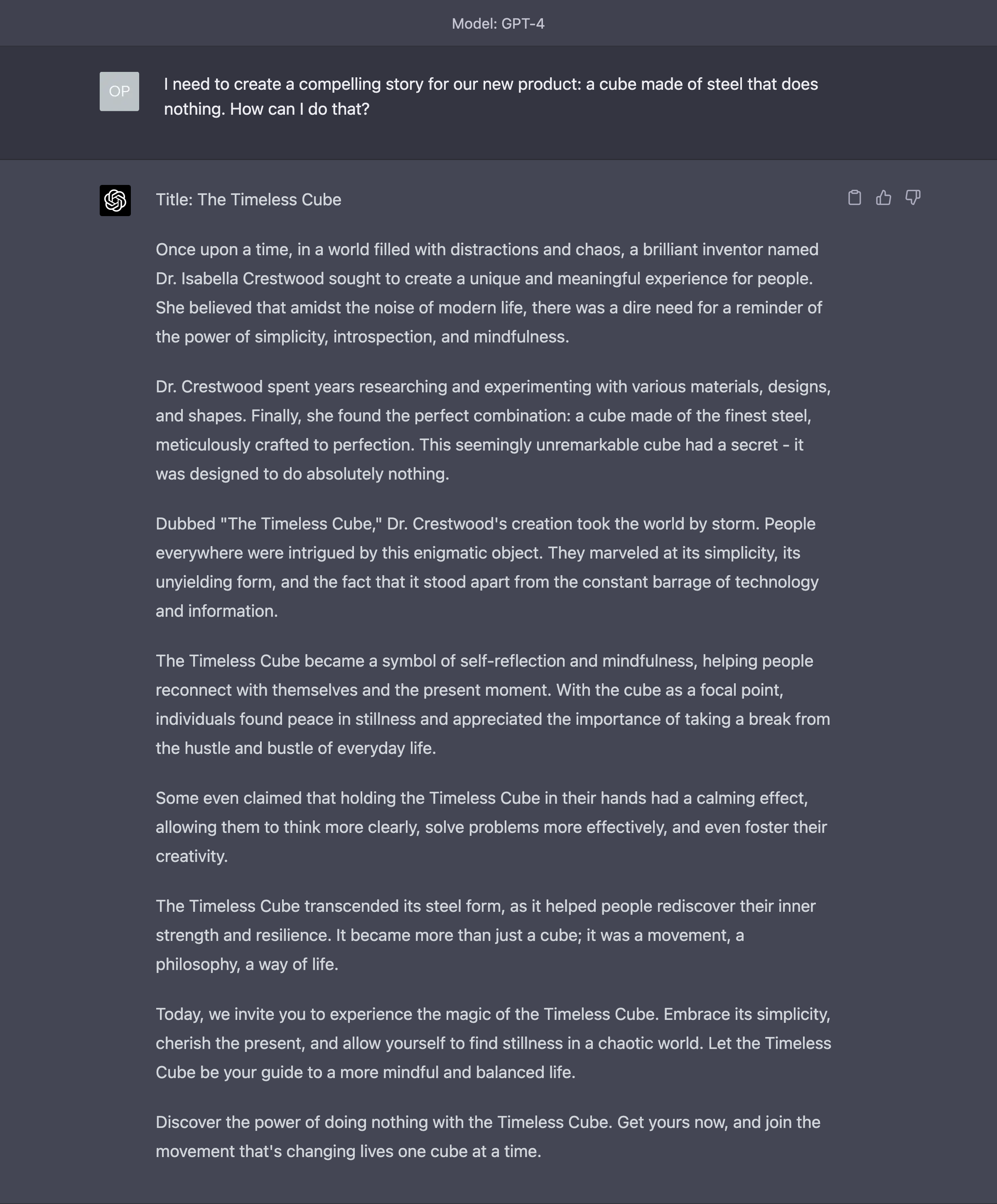
This is not bad as a bedtime story for a three years old and, in there, there are some interesting ideas. But, as is, it’s garbage for professional use.
You’d have two options.
The first would be to do heavy editing, but in many cases, you’ll find out that it’s easier to write the whole thing by yourself.
The second is to ask for a variant in the hope that the AI generates a version of the story that is more useful. This is what happens with generative AI for image generation systems like Dall-E 2, Stable Diffusion, or Midjourney.
You keep generating images by making minor tweaks to your original prompt until you get to something useful.
There’s a better, third option: ask the AI to approach the problem in steps.
This is what you get with this simple request:
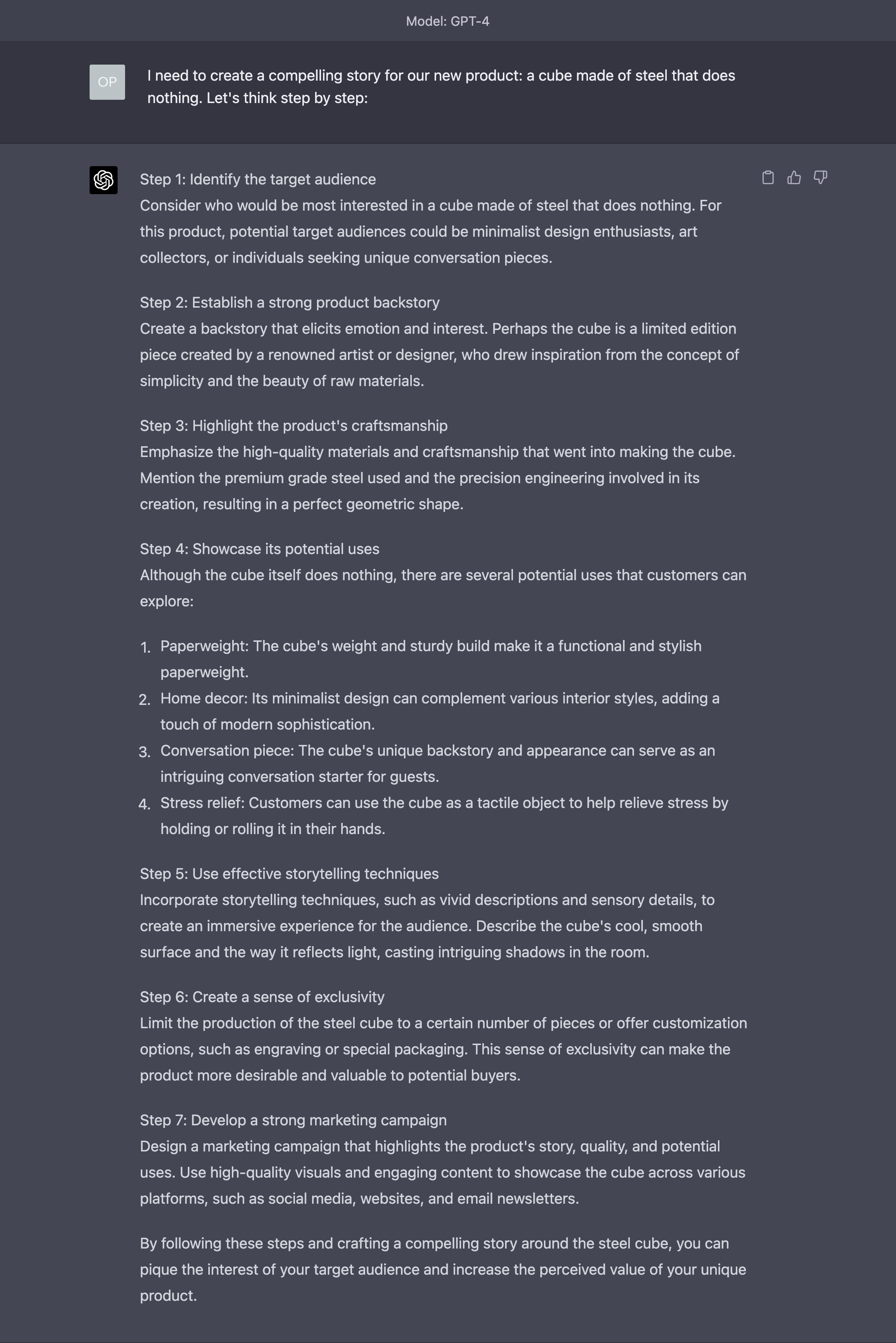
You can see that the answer is not only more articulated but exposes the reasoning driving the narrative that the AI is suggesting. That makes it easier to adapt the story to your particular use case or to adjust portions of it.
Researchers have found that the step-by-step technique is particularly effective in many scenarios, especially when used in conjunction with the Lead by Example technique, which we discussed in Issue #8 – The Harbinger of Change.
As a dear reader of Synthetic Work reminded me, until recently, and for over one year, I used to ask on social media, every week, the following question: “What is the book that changed your life?”
Throughout the period, I collected 150 book recommendations, which gave me an invaluable opportunity to get to know better the people I’m connected with on LinkedIn and Twitter.
Then Twitter changed its access policy and it has become complicated to carry on the exercise in a fully automated way. I could type that question manually every week, but I’m too upset and I still need to get over it.
Well, is somebody would ask me What is the tool that changed your life? I would respond Grammarly. So much so, that the company has been in my Startups Worth Watching list since 2016.
So today we talk about Grammarly, as they recently activated new capabilities based on generative AI.
Grammarly always used AI extensively, not just to suggest grammar, spelling, and punctuation corrections in real-time, but also to improve the style of your writing.
If you subscribe to the Premium version of Grammarly, you would receive suggestions on how to improve a wide range of qualities:
- the consistency in punctuation
- the English fluency (super helpful for those writers that were born in countries where English is not the first language, like me)
- the conciseness to help you get to the point quicker
- the choice of words and the variety of sentences to make your writing more engaging, the tone delivery
- the tone detection so you know when you sound formal or informal, friendly or diplomatic, sincere or confident, constructive or pedantic
The Premium version does other cool things like automatically formatting citations or checking for plagiarism, but I didn’t test them enough to talk about them.
When I was writing virtualization.info, my first media project, started twenty years ago, I could barely speak or write in English (some readers of the Splendid Edition certainly remember that!), even just the features in the free version of Grammarly would have radically improved the quality of my writing.
When I joined Gartner as a research director, after my experience with virtualization.info, like every other analyst at the company, I was assisted by a team of some of the best linguists on the planet, coming from Oxford and Cambridge, who taught me how to be concise, coherent, and how you can improve your writing without killing your unique voice (something that too few people working in corporate marketing around the world know how to do).
That perk alone was worth the job and I learned a tremendous amount on how to write. It’s not exactly the same, as there is no back and forth interaction with extensive explanation, but the feature that Grammarly Premium offers are the closest thing to the education I received in Gartner.
The other thing you learn in Gartner, and you see it with your own eyes even if are a sceptic, is that the quality of your communication has a huge impact on your capability to establish your relevance and influence others. Because of that experience, I’m probably more sensitive to what Grammarly has to offer than the average person.
The one thing that Grammarly struggles to do in this area is accommodating intentional abuses to grammar to develop a particular writing style.
For example, I love to use the rethorical device called anaphora. Grammarly doesn’t like that very much and we are constantly bickering about it.
Similarly, I love to break a sequence of formal or professional paragraphs with a very informal and colloquial paragraph. Boy, does Grammarly hate that.
Or, I love to use the so-called historical present (or narrative present) for some parts of a long writing, like this newsletter, and Grammarly is really not impressed by my consistency.
It’s not its fault. The tool is not designed to tolerate style acrobatics, but to not make you sound like a fool.
Regarldless of these little disagreements, normal in any marriage, I barely write a line without passing it through Grammarly.
If you are writing something inside any major browser, like when you use Google Docs or WordPress.com, on when you write a post on LinkedIn or Twitter, the Grammarly extension starts suggesting corrections in a frictionless way.
They also offer a basic text editor where you can go and write pieces from scratch, but I rarely use it.
They even have a keyboard for iOS, which would be incredibly handy if the swiping and cursor repositioning capabilities were as good as GBoard. Unfortunately, they are not, and over the years, they have not improved.
What they don’t have is an extension for Thunderbird, which I insist on using for all my emails on the desktop, despite being slow and with a UI straight from the Ice Age.
If the email I’m writing is really important, I simply write the text I want to write inside the Grammarly editor and then copy the corrected version inside Thunderbird. It’s a lot of friction, but I’d rather kill myself than use the web interface of Gmail.
Yet, Grammarly doesn’t catch all my mistakes. Sometimes, the browser extension is slow at identifying misspelt words or typos, or at telling me “Look, this word that you think exists, it really doesn’t. It’s only in your mind and I don’t even know what to suggest as an alternative.”
If the extension is too slow, I send the text (or copy it to use it elsewhere), sure that I’ve done a great job and the reputational damage is done.
Nonetheless, I couldn’t part part from Grammarly. Not because I lack the confidence to write without it (an emerging risk as we increase our reliance on AI tools of all sorts), but because I learn a ton every time it corrects me.
In fact, I can’t imagine how somebody would not benefit from it.
Over the twenty years since I wrote the first page of virtualization.info, the thing that has shocked me the most is how many English-native speakers would benefit from the Premium subscription to Grammarly. And I’m talking about highly-educated people with VP roles in large enterprise companies making millions of dollars in yearly salary.
So, for what I’m concerned, I could be done with this post. But no. We need to talk about the new stuff, based on generative AI.
Of course, like every other company on the planet, Grammarly had to find a way to leverage large language models like GPT-4 and capture the incredible momentum around the world.
Different from most of the other companies on the planet, tho, Grammarly is a really good fit for generative AI.
The new offering, currently in beta, is called GrammarlyGO and it’s available for both Free and Premium subscriptions.
The interaction is as frictionless as always. If your cursor is on a new line, and you click on the green bulb inside the Grammarly little overlay, GrammarlyGO will help you to come up with new things to write (what polite people call writer’s block when they really mean that you are a lazy bum) or the best way to write something you want to say:
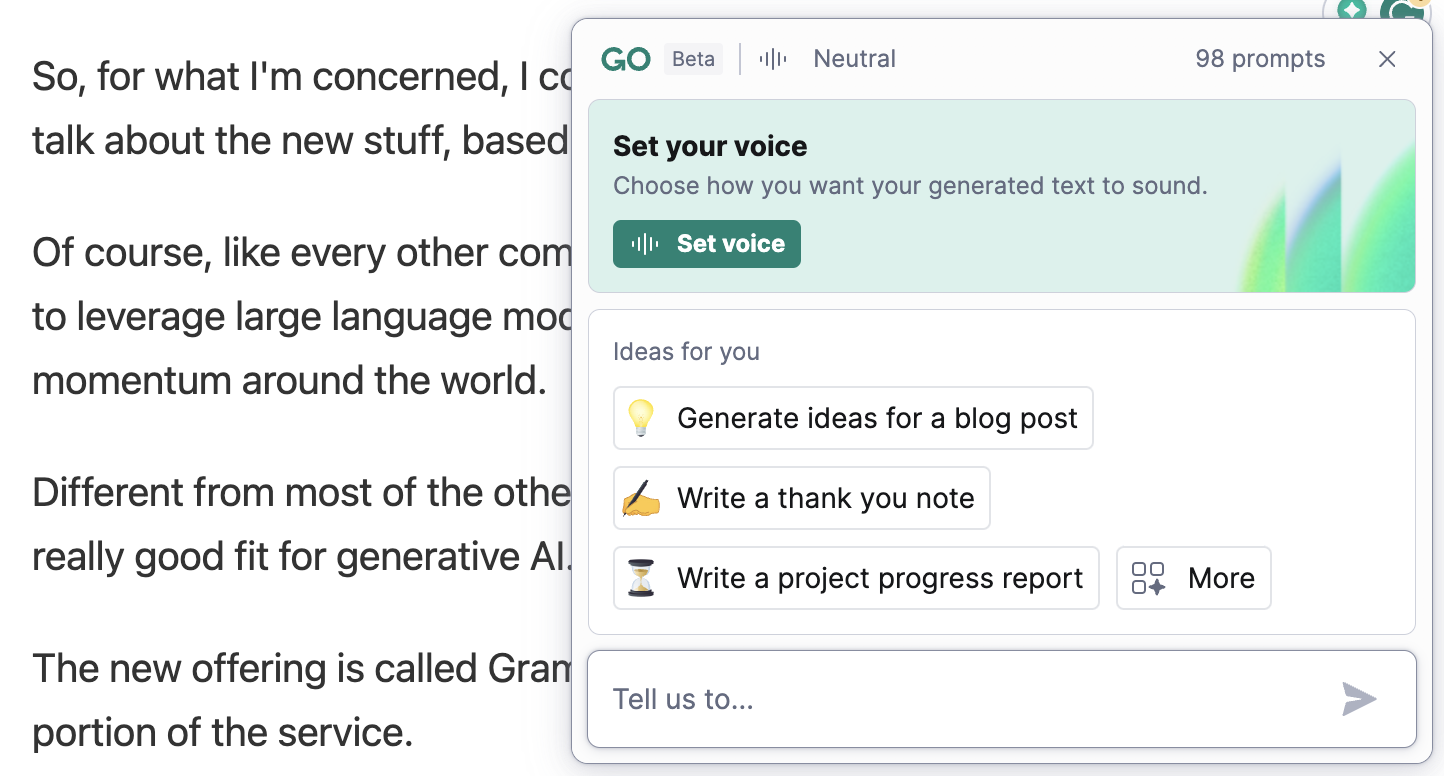
You can set your voice in terms of style and language conventions you want to be consistent with:
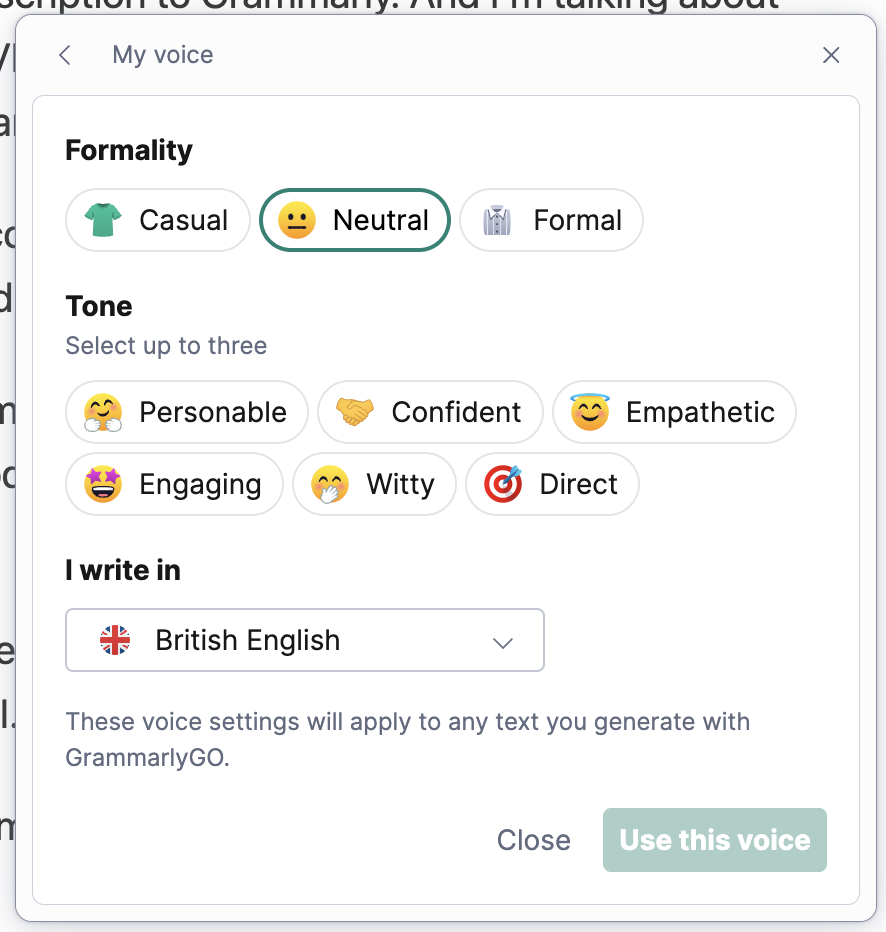
If you select a paragraph that you already wrote, instead, GrammarlyGO will help you rephrase it entirely to make it more concise, engaging, alluring, beautiful, golden.
Some of these things were already available with the other capabilities of the Premium edition, but in GrammarlyGO they are all applied at the same time, automatically. Grammarly simply suggests an improved version of what you wrote without you having to think too much about it:
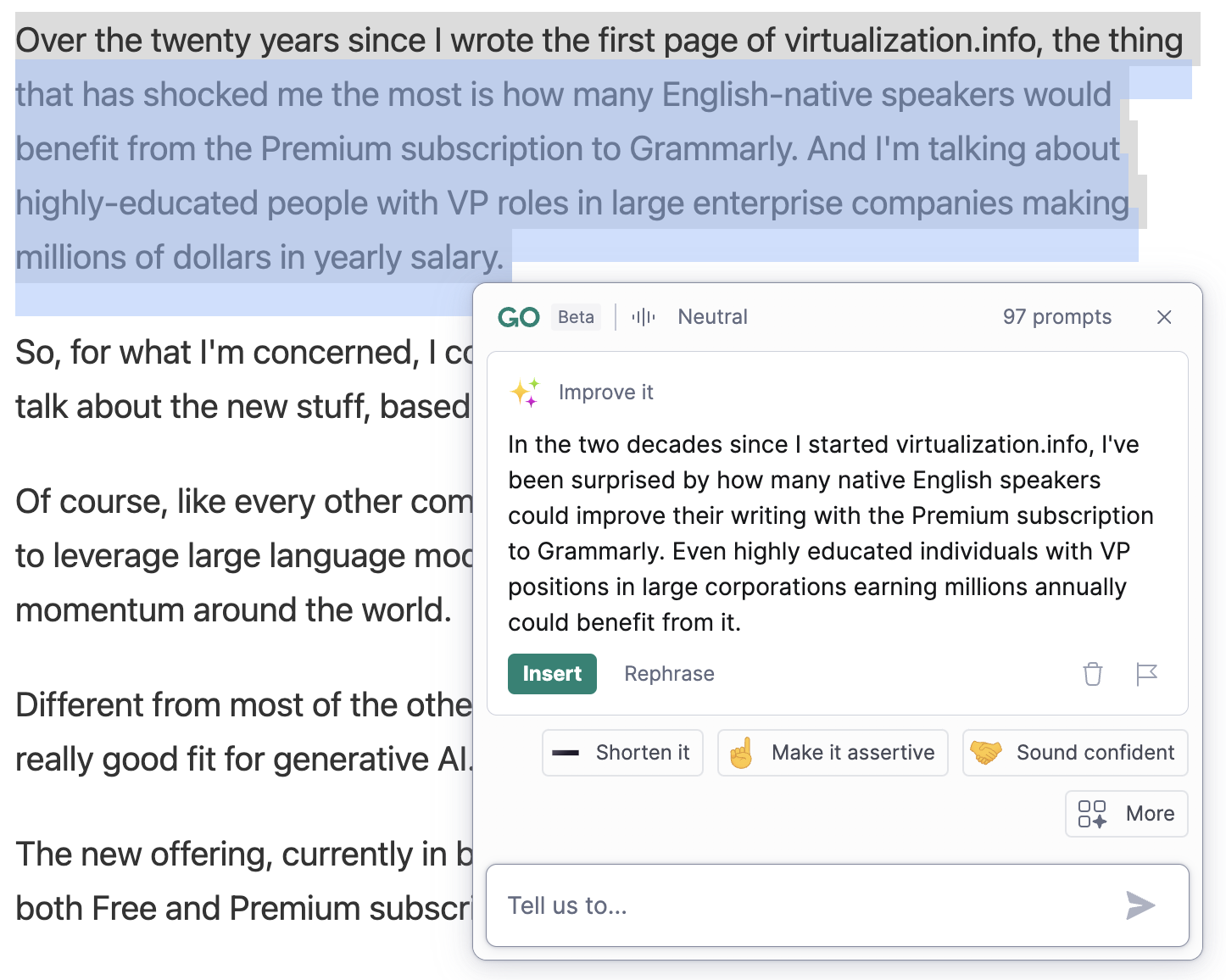
As I previously complained, the result might be more pleasant but it radically changes the way you say things.
At this point, you can ask for further refinements, like for example an even more concise version, but here things start to fall apart:
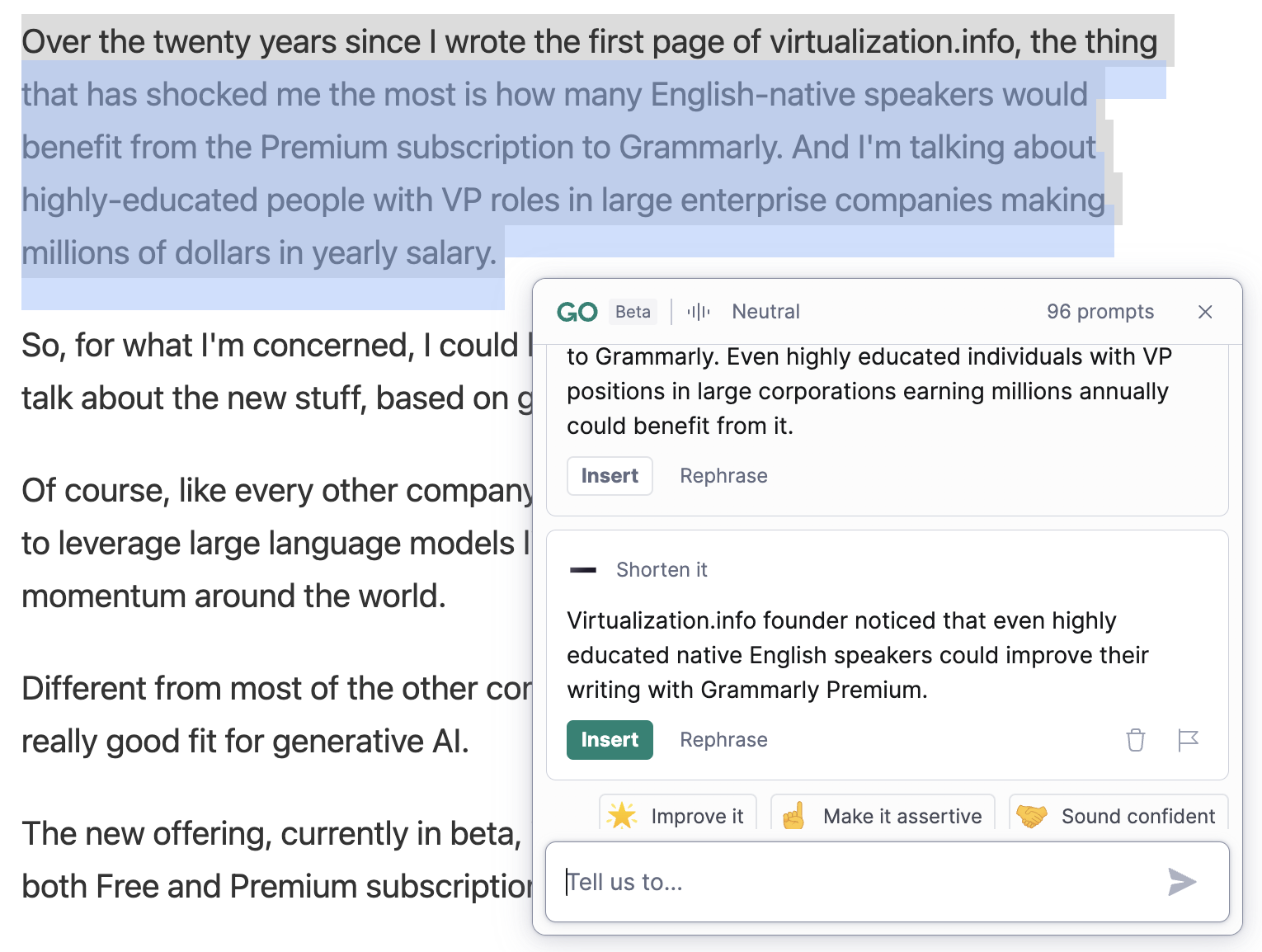
So what’s happening here?
Like many other companies are doing when implementing large language models, in each of these new use cases, Grammarly is taking your input (which is your prompt) and massaging it with its own prompt.
If their prompt is not appropriately crafted, the answer they get back from the large language model is equally inappropriate.
It’s a beta and I don’t know if Grammarly is integrating with ChatGPT, with GPT-4, or using their own LLM. It will get better not just because the company will adopt the best performing LLM, but also because Grammarly users are unsuspecting helping the AI to give better answers.
The technique, which we already mentioned multiple times in Synthetic Work, is called Reinforcement Learning from Human Feedback (RLHF) and it’s the fundamental mechanism that is currently improving all the best AI systems out there, from GPT-4 to Midjourney.
That’s why Grammarly is offering GO also to non-paying customers. They need us to help fine-tune the AI model.
All of this to say that every time you interact with GrammarlyGO, even by just highlighting a paragraph and activating the system, you are submitting a prompt to the AI.
Free users have 100 prompts/month while Premium users have 500 prompts/month. Which is not much. Which makes me believe that Grammarly is calling GPT-4 under the hood.
The integration with GPT-4 is very expensive at the moment, and the Premium subscription might not be enough to cover the expenses for more than 500 prompts a month.
This, too, will improve as OpenAI dramatically lowers the costs of GPT-4 integrations or Grammarly switches to its own LLMs. They have an ocean of text to train it with.
All of this leads us to a final consideration, applicable to Grammarly and any other tool that depends on the integration with OpenAI.
Will people continue to spend $25/month for Grammarly Premium or will switch $20/month to use GPT-4 from the OpenAI web interface?
Of course, if we’d have to copy and paste back and forth all the text he/she writes for grammar correction and style improvement, nobody would use GPT-4 as an alternative to Grammarly. A huge part of the value is in the frictionless and ubiquitous experience.
But it’s possible to build alternatives to Grammarly on top of the GPT-4 APIs and, with great prompting skills, perhaps even come up with a competitive alternative that costs only a small amount on top of the OpenAI subscription.
It’s even possible that the open source community will come up with an open source competitor of Grammarly that costs nothing but the subscription to GPT-4 (and, as StableLM starts to become a thing, not even that).
So the question always is: how can companies in almost every software category establish and defend their competitive moat against OpenAI?
We are already seeing the owners of very precious data, like Twitter or Reddit, closing their access to generative AI companies. Their data is not just highly valuable as a quality source for AI training. It’s also the very thing that might equip a future competitor with the AI model to drive them out of business.
It is likely that every company out there, including Grammarly, will become increasingly protective of their existing data and increasingly aggressive in collecting more data. While GPT-4 is the only game in town, that’s all they can do.
But, eventually, open source large language models like StableLM will become viable alternatives to GPT-4, and Twitter, Reddit, Grammarly and many others might have to embrace them as the only way to stay competitive.
In other words, you either offer AI capabilities based on an open source LLM and your proprietary dataset, or you become a dataset that ends up training the proprietary model used by your cheaper competitor.
